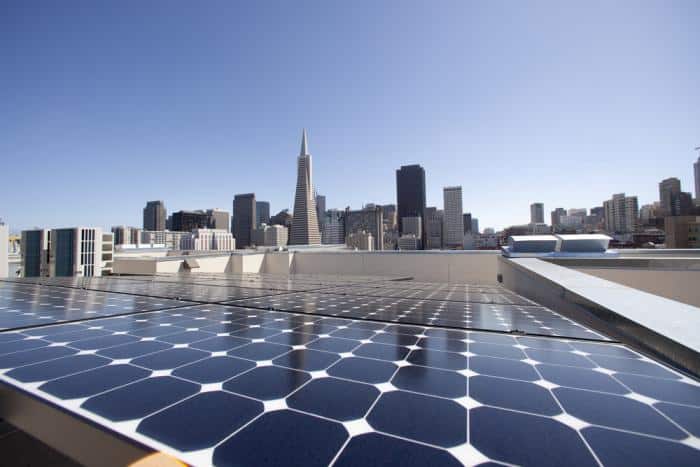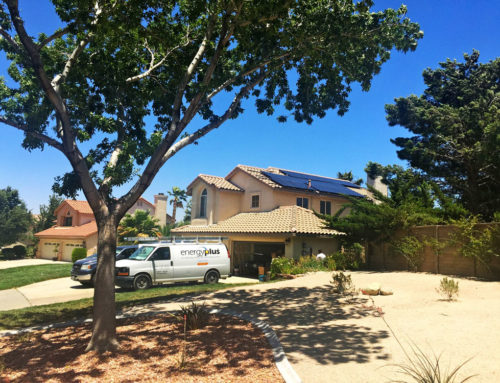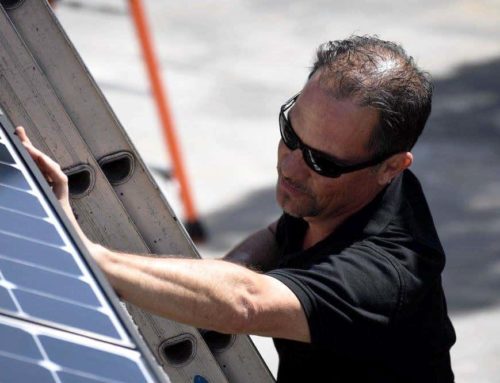Confusion over the impact of heat and light in solar power starts with the fact that there are different types of solar power. One type of power, called solar thermal, does use the sun’s light to generate heat which can be used for things like household hot water or to generate steam to drive turbines and generate electricity. But those panels involve complex integration with hot water systems to operate.
The other type of solar power is generated by photovoltaic (PV) solar panels, which use light to generate electricity directly. Many people think the most efficient place to generate power with photovoltaic (PV) solar panels is a scorching hot desert where the sun bakes everything. They couldn’t be more wrong.
Sure, there’s plenty of sunlight. But electronics – like the equipment in a PV solar system – actually work more efficiently in cold weather, not just the dog days of summer.
The standard testing temperature for rating the wattage of PV solar panels is 77 degrees Fahrenheit (or 25 degrees Celsius). On a broiling hot day, solar panels gradually lose efficiency the higher the thermostat climbs. But advanced solar panels – like SunPower’s – are designed to minimize these losses. In fact, SunPower® panels boast a super-low “temperature coefficient,” or heat-related power decline.
Nevertheless, cold weather can be just the ticket for PV solar efficiency. Imagine a brisk, clear winter day. That’s the sweet spot for generating PV solar power. Even snow can help by reflecting sunlight on the panels – as long as it’s not actually covering the panels.
You see, the photovoltaic (PV) cells solar panels access primarily use the visible spectrum for power production. Some of that light is visible to the human eye, and some of it – like infrared and ultraviolet light – are not visible. Clouds may block out a lot of the visible light, but they don’t block out the entire spectrum (explaining why you still get sunburned when it’s cloudy). SunPower panels use both more infrared and more ultraviolet light than other panels. This, combined with the fact that they are more efficient1, may mean homeowners require fewer panels.
OTHER FACTORS INVOLVED IN ENERGY PRODUCTION
Temperature and the spectrum of light have a big impact on how much power solar panels can generate. But so does the angle of the sun’s light. The angle becomes a big deal when SunPower Master Dealers plan PV solar systems for homeowners. Every home installation is unique because each house faces the sun differently, and well-oriented panels can help capture more sunlight during peak times of the day. You see, panel efficiency is measured with the light straight ahead. But on most roofs, the sun is rarely perpendicular to the panel. So off-angle performance – such as when the sun is low in the sky – is important.
The amount of light also plays a role in energy production. Generally speaking, there’s more daylight around noon than any other time of day, and a house’s location can play a big role in the amount of light that enters solar panels. For instance, a house on a hillside may get great light in the morning but not much in the afternoon. Many houses have problems with shading from trees and other obstacles. And dust or leaves also can lower output.
SunPower maximizes the available light with solar panels that are 30 percent more efficient than conventional panels. Because SunPower panels offer higher efficiency than conventional panels, they take up less space, making it less likely that they’ll be placed in shady parts of a roof or lawn. SunPower panels also come equipped with microinverters that help mitigate shading.
All of the factors discussed thus far impact the energy production of a new system. However, it’s also important to make sure that the system will stand the test of time. The leading cause of degradation (aka wearing down) of conventional panels are corrosion and nearly invisible cracks in the cells, which reduce output. SunPower’s solar panels are designed for a useful life of more than 40 years2, thanks to a solid (but flexible) metal foundation that our cells are built on. In fact, SunPower Maxeon® panels have the industry’s lowest solar panel degradation rate.3 That means SunPower panels produce more energy over a longer period of time.
Using a renewable source like sunlight to generate energy can reduce the carbon generation that can cause climate change. But the biggest benefit of using solar energy to power your house is lower electricity bills that can last for decades. Contact SunPower to find out more.
1 Based on datasheet review of websites of top 20 manufacturers per IHS, as of May, 2019.
2 SunPower Module 40-Year Useful Life,” SunPower white paper. 2013. Useful life is 99 out of 100 panels operating at more than 70% of rated power.
3 Jordan, et al, “Robust PV Degradation Methodology Application” PVSC 2018 and “Compendium of Photovoltaic Degradation Rates” PiP 2016
This post originally appeared on the SunPower Resource Blog







